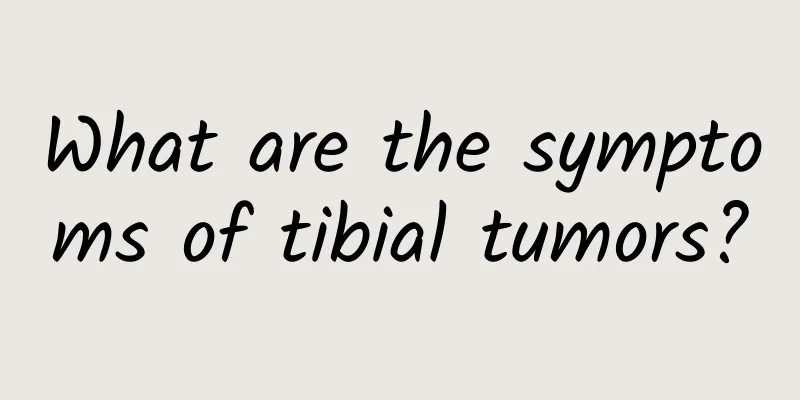What are the symptoms of tibial tumors?

|
Tibial tumors are generally benign tumors with many causes. They are manifested as no local tenderness. Of course, if the tumor grows quickly, it may also become malignant. If it compresses nerves or blood vessels, the damage becomes very serious. At this time, Timely treatment can avoid greater harm to your health. There are many treatment methods, and the most effective one is surgical resection.Clinical manifestations Any bone that is formed by cartilage can develop an osteochondroma, and long tubular bones are more common than flat bones and short bones. The most common sites are the distal femur, proximal tibia and proximal humerus. The tumor does not cause pain and is often discovered by accidental feeling of a lump or by X-ray examination. There is often no local tenderness, but some symptoms may occur due to compression of blood vessels, nerves and internal organs. The medial bone extrusion at the lower end of the femur or upper end of the tibia may feel like tendon sliding. Pain is felt only after the tumor is directly impacted or a fracture occurs at the pedicle. When the tumor is large, it may compress the nerves. Bone warts on the lumbar spine may cause compression symptoms of the cauda equina. Swelling of the feet and ankles can make walking and wearing shoes difficult and may be complicated by bursae or bursitis. examine The X-ray manifestation of osteochondroma is a bone lesion protruding from the epiphysis. Because the cartilage cap and bursa are not visible, the bone image of the tumor is exactly the same as the bone structure of the epiphysis where it is located, making it difficult to distinguish. The growth direction of tumors located in long bones is consistent with the direction of traction of the adjacent muscles. Osteochondromas at the distal end of the femur grow toward the femur, and tumors at the proximal end of the tibia grow toward the distal end of the tibia. They have different shapes and may have a very long pedicle and a narrow base, or a very short and thick base with a broad base. Larger tumors have a cauliflower-like bulge at the top. treat The only effective treatment for osteochondroma is surgical resection. In the past, it was considered that the tumor would stop growing as the epiphyseal plate closed and that the rate of malignant transformation was extremely low (0.5% to 1% for single lesions and about 2% for multiple lesions). Surgical resection was only indicated when local pain occurred, joint movement was impeded, or blood vessels, nerves, and organs were compressed. It is currently advocated that once a single osteochondroma is diagnosed, it should be surgically removed at a scheduled time. Multiple osteochondromas are numerous and difficult to remove in one surgery. It is difficult for patients to accept the need for several or dozens of surgeries to remove the tumors. Only those osteochondromas that cause symptoms or interfere with joint movement and are accompanied by limb deformities can be selectively removed. Corrective surgery for limb deformity can be performed in one stage with tumor resection or in stages, depending on its complexity. If the tumor compresses nerves, blood vessels or affects joint movement, or if fracture occurs due to pedicle trauma, surgical resection is an indication. The focus of the operation is to remove the base without peeling off the local periosteum. The cartilage cap and periosteum should be removed together to avoid tumor recurrence and damage to the epiphyseal plate. |
<<: What are the symptoms of baby's cervical spine injury?
>>: What are the symptoms of wisdom tooth extraction wound infection
Recommend
There are white spots on the baby's body
When a baby is just born, his physical fitness is...
Monthly developmental characteristics of babies
Many people say that children grow very fast and ...
Tattoos to cover scars
Although medical technology is becoming more and ...
Best treatment for flat warts
Flat warts are mainly a common skin disease. Flat...
Why do you get otitis media?
Otitis media may not be familiar to ordinary peop...
What kind of tea is good for eyes and improves eyesight?
Drinking some tea properly on a regular basis is ...
What are the ways to cook clams?
There are actually different ways to cook clams, ...
What should I do if the thermometer is broken?
Common mercury thermometers are surrounded by gla...
Anxiety Disorders Symptoms and Treatment
There are many symptoms of anxiety disorder, whic...
Can hepatitis C be cured?
Among many diseases, hepatitis C is a relatively ...
Does Rhodiola Rosea nourish the kidneys?
Can Rhodiola rosea nourish the kidneys and streng...
Symptoms of soft tissue injury of the knee
Injury to the soft tissue of the knee. Generally ...
Best rehabilitation plan for Achilles tendon rupture
When the Achilles tendon ruptures, surgical treat...
What are the benefits of drinking a glass of water in the morning?
Water is the source of life. If people want to li...
What causes synovitis? Here are the reasons
The causes of synovitis are different, and there ...









